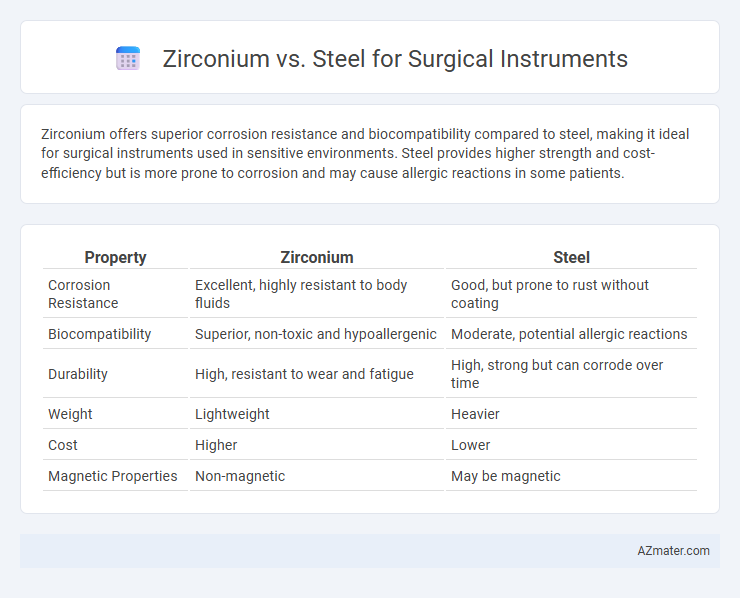Zirconium offers superior corrosion resistance and biocompatibility compared to steel, making it ideal for surgical instruments used in sensitive environments. Steel provides higher strength and cost-efficiency but is more prone to corrosion and may cause allergic reactions in some patients.
Table of Comparison
| Property | Zirconium | Steel |
|---|---|---|
| Corrosion Resistance | Excellent, highly resistant to body fluids | Good, but prone to rust without coating |
| Biocompatibility | Superior, non-toxic and hypoallergenic | Moderate, potential allergic reactions |
| Durability | High, resistant to wear and fatigue | High, strong but can corrode over time |
| Weight | Lightweight | Heavier |
| Cost | Higher | Lower |
| Magnetic Properties | Non-magnetic | May be magnetic |
Introduction to Surgical Instrument Materials
Zirconium and steel are prominent materials used in manufacturing surgical instruments due to their distinct biocompatibility and mechanical properties. Zirconium, known for its corrosion resistance and hypoallergenic nature, offers superior durability and reduced risk of allergic reactions compared to traditional surgical stainless steel. Steel, particularly surgical-grade stainless steel like 316L, provides high strength, affordability, and ease of sterilization, making it widely preferred in various surgical applications.
Overview of Zirconium in Surgical Instruments
Zirconium in surgical instruments offers exceptional biocompatibility and corrosion resistance, making it ideal for long-term implantation and repeated sterilization. Its non-magnetic properties and hypoallergenic nature reduce patient risks compared to steel, which can cause allergic reactions and magnetic interference in imaging devices. Zirconium's superior durability and resistance to wear also contribute to precision and longevity in critical surgical environments.
Overview of Steel in Surgical Instruments
Steel, specifically stainless steel, dominates surgical instruments due to its exceptional strength, corrosion resistance, and ability to maintain sharp edges. Surgical-grade stainless steel, such as 316L and 440C, offers durability and biocompatibility essential for repeated sterilization and use. Its cost-effectiveness and ease of manufacturing further reinforce steel as the standard choice in medical tool production.
Biocompatibility: Zirconium vs Steel
Zirconium exhibits superior biocompatibility compared to steel, making it highly suitable for surgical instruments used in sensitive procedures. Unlike steel, zirconium forms a stable, inert oxide layer that resists corrosion and minimizes the risk of allergic reactions or metal ion release in the body. This biocompatible property ensures zirconium instruments reduce tissue irritation and promote safer healing outcomes in surgical environments.
Corrosion Resistance and Durability
Zirconium exhibits superior corrosion resistance compared to steel due to its stable oxide layer, which effectively prevents degradation in harsh surgical environments. Its durability under repeated sterilization cycles makes it ideal for instruments exposed to aggressive chemicals and high temperatures. Steel, while strong and cost-effective, is more prone to rust and corrosion, necessitating coatings or alloys to enhance its longevity in medical applications.
Strength and Performance Comparison
Zirconium offers superior corrosion resistance and biocompatibility compared to steel, making it a preferred choice for surgical instruments exposed to harsh sterilization processes. In terms of strength, surgical-grade stainless steel, especially types like 316L, demonstrates higher tensile strength and durability under repeated mechanical stress. However, zirconium's enhanced wear resistance and lower thermal conductivity contribute to better performance in specialized surgical applications requiring precision and longevity.
Weight and Ergonomics in the Operating Room
Zirconium surgical instruments offer a significantly lighter weight compared to traditional steel, reducing surgeon fatigue during prolonged procedures. The reduced density of zirconium enhances maneuverability and precision, contributing to improved ergonomics in the operating room. This weight advantage, combined with its biocompatibility and corrosion resistance, makes zirconium an optimal choice for instruments requiring high dexterity and comfort.
Sterilization: Ease and Effectiveness
Zirconium surgical instruments offer superior corrosion resistance and maintain structural integrity after repeated sterilization cycles compared to steel, enhancing ease of sterilization. Steel instruments, especially stainless steel, are durable but may experience surface degradation and corrosion from frequent exposure to high-temperature steam or chemical sterilization methods. Zirconium's non-reactive surface minimizes biofilm adherence, ensuring more effective sterilization and reducing infection risks in surgical settings.
Cost Considerations for Healthcare Facilities
Zirconium surgical instruments generally entail higher upfront costs compared to steel due to advanced manufacturing processes and material rarity. Steel instruments offer a cost-effective option with lower initial investment and widespread availability, benefiting budget-conscious healthcare facilities. Long-term cost analysis should include factors such as durability, corrosion resistance, and sterilization efficiency, where zirconium may provide value by reducing replacement frequency and maintenance expenses.
Choosing the Right Material: Zirconium or Steel?
Zirconium offers superior corrosion resistance and biocompatibility, making it ideal for surgical instruments exposed to harsh sterilization processes and patient contact. Steel, particularly stainless steel, provides outstanding strength, durability, and cost-effectiveness, commonly favored for instruments requiring rigorous mechanical performance. Selecting the right material depends on balancing corrosion resistance and biocompatibility (favoring zirconium) against strength and affordability (favoring steel) to meet specific surgical demands.

Infographic: Zirconium vs Steel for Surgical Instrument
 azmater.com
azmater.com